
Shape fractal: technology of a smart systems
AH-1 Improving processes, change transitions, using the 6*6 reference framework
Improving processes - change transitions
Explaining - predicting, processing operations.
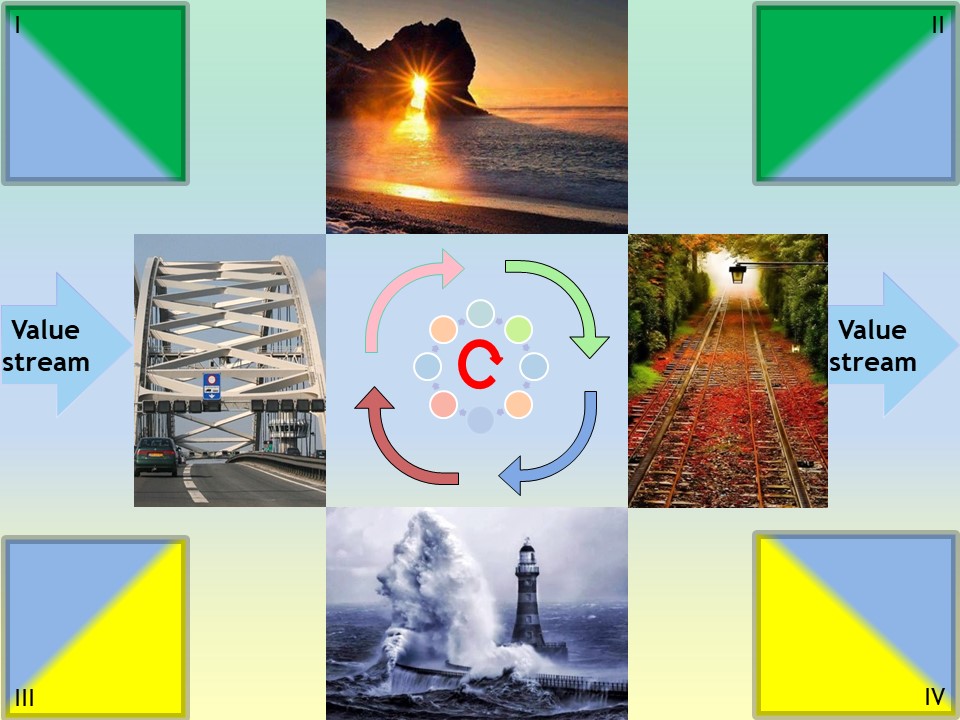
The world of BI and Analytics is challenging.
The Application Life Cycle model2 is underpinning decisions for in the boardroom.
To know what is going on and what is needed, distance on details is required.
🔰 Most logical
back reference.
Contents
| Reference | Topic | Squad |
| Intro | Explaining - predicting, processing operations. | 01.01 |
| Why Bi&A (I) | Why BI & Analytics (I). | 02.01 |
| Why Bi&A (II) | Why BI & Analytics (II). | 03.01 |
| BI_proces | Business Intelligence Proces. | 04.01 |
| ANA_proces | Analytical Proces. | 05.01 |
| What next | Inventing changing Operations. | 06.00 |
| | Combined pages as single topic. | 06.02 |

Combined pages as single topic.
👓 info types different types of information
👓 Value Stream of the information product
👓 transform information Working cell
🚧 bi tech Business Intelligence, Analytics
🕶 data silo - BI analytics, reporting
Progress
THis chapter is partially fresh, partially converted. Topics are:
- 2019 week 41
- Changed location to a sub page.
- Realizing Analytics, optimizing the proces is like: lean TPS.
- 2019 week 18
- Adjusting page frame.
- Realizing ALC model2 can use analytics for reporting, but that is different to using analytics following ALC model3.
- 2019 week 15
- This page set up with old illustrations, added Machine learing versus BI.
- To do: Check what is missed and still relevant to convert.

Why BI & Analytics (I).
Supporting Business proces optimization.
Business Intelligence (BI), Management Information System (MIS), Executive Information System (EIS) are alle the same, just using different words.
Informing the decision makers (business).
The goal is only informing management with figures so they can make their mind up with what do in the future.
The spreadsheet use by mangement doing the analyses for decisions.
At other layers "BI & analytics" is used:
- optimizing the middleware layer. Servicing the business balancing performance and cost factors. Optimization of ICT.
- The datacenter optimizing using the machines, analyzing possible generic security threats. Optimization of ICT.
BI & Analytics is not a "one size fits all" solution.
Informing by descriptive reporting.
In the years before BI was normal, the standard reports were delivered as being part of the proces job log.
The reports being printed on paper were archived for a long period, requiring a lot of space and cabinets.
Extracting those numbers, figures, was later done by archiving those prints in an electronic way (datasets).
The conversion of those electronic datasets was the first dwh being build. The spreadsheet being a key enabler replacing most of manual work.
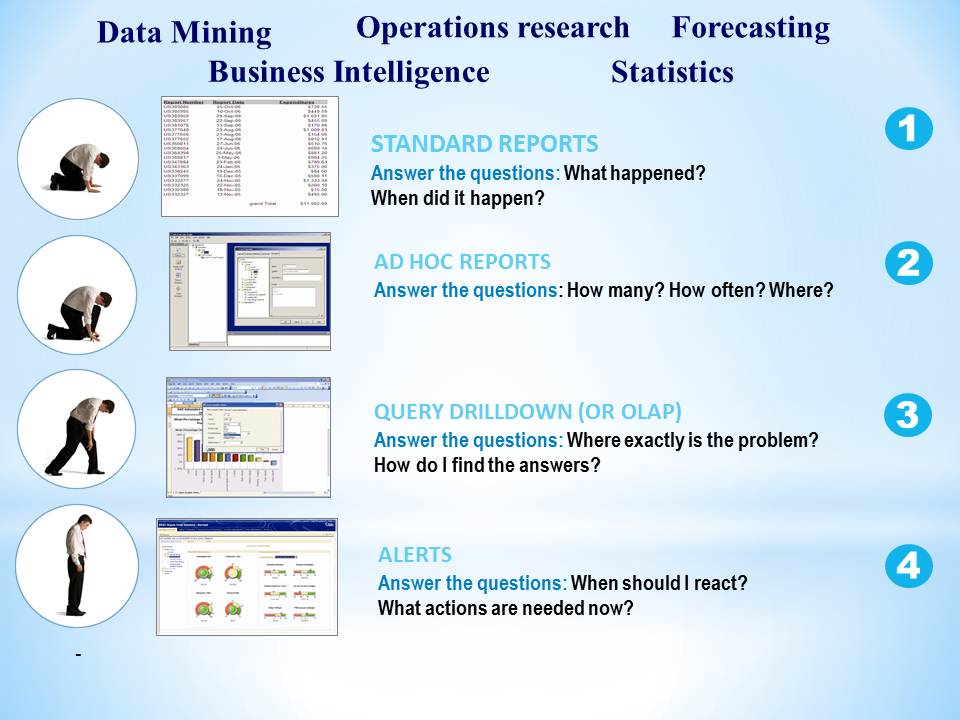
📚 short list:
* standard
* ad hoc
* drill down
* alerts
Bi as the next thing of report log
First BI&A usage:
- Moving the evaluation log to BI tools
⚙ Every Job did have an associated rprot printed what has happend.
⚒ The change into collection of those reports into:
📚 " Intelligence".

Why BI & Analytics (II).
Analytics, Operations Research (BI) is coming wiht a lot of uncertainties. Monte Carlo simulations being optional.
Informing by predictive, prescriptive reporting.
This is augmenting reporting, doing extrapolations, regresions in probablities what could happen.
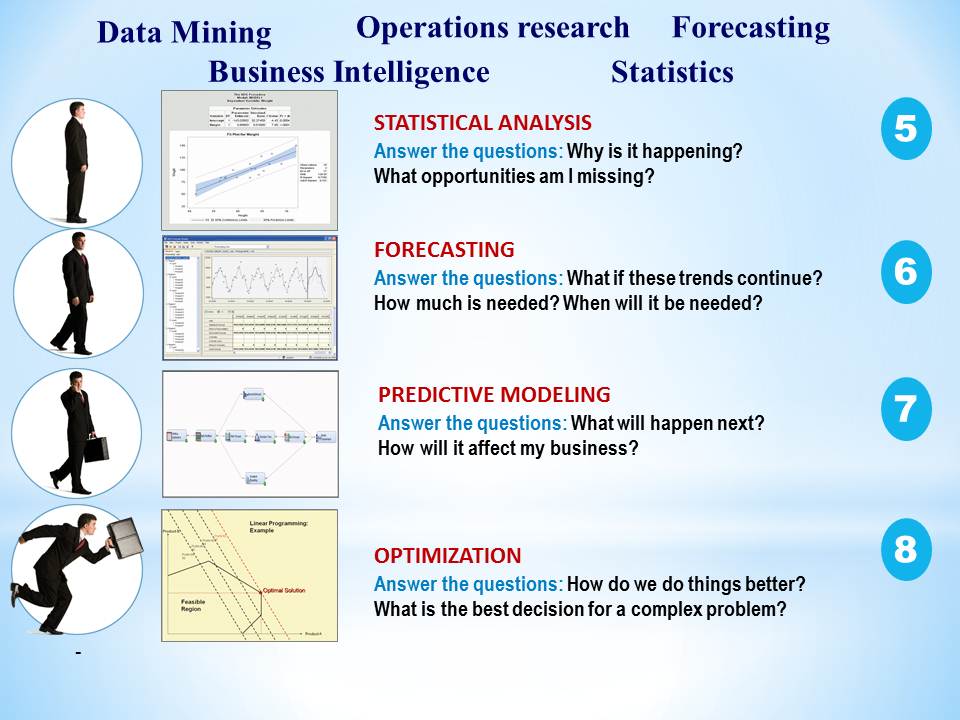 ⚖
⚖ short list:
* statistics
* forecasting
* predictions
* optimizations
Analytics and Bi differences
Different type of BI&A usage:
- Operations using BI tools
⚙ No preparation on what is needed neither evaluation what has done.
⚒ Focus: running the operations.
- BI, Business Intelligence (dashboard-report)
📚 Information is being gathered wiht a discussed goal to achieve.
⚙ ⚒ Data is being processed. Prepare for the goal.
🎭 Results are evaluated, planning what do next.
- AI, BI enhanced with analytical tools (dashboard-report)
⚖ ⚙ Information is being gathered having no clear goal to achieve.
📚 ⚒ Modelling - analyzing using data, to find new unknown opportunities.
🎭 Results are evaluated, planning what do next.
- AI, ML Machine Learning, operational scoring
⚖ ⚙ Information is being gathered with a discussed goal to achieve.
📚 ⚒ Modeling - analyzing data for the best approach.
🎭 Results associated wiht tested models are evaluated.
⚙ Data is processed using accepted chosen models.
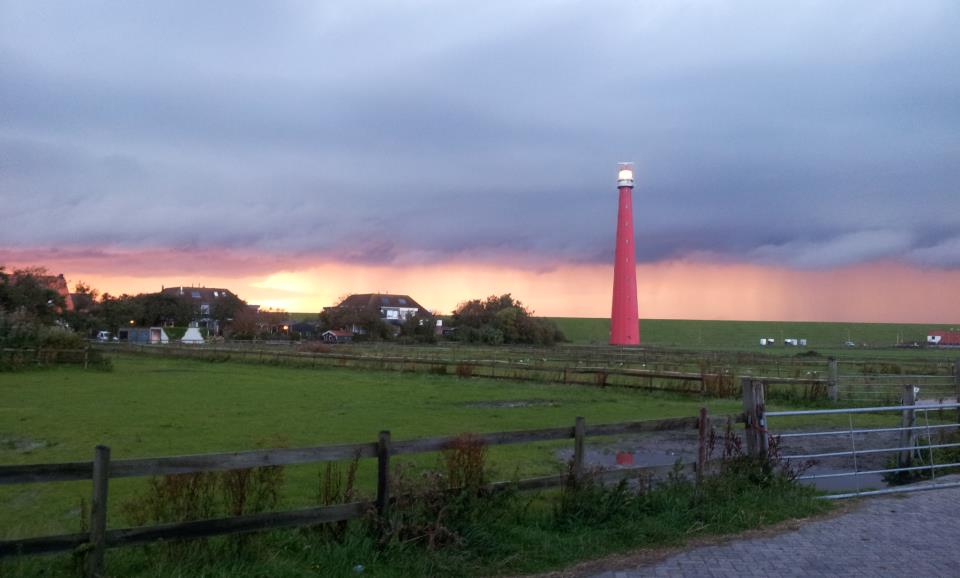
Business Intelligence Proces.
The classic approach is delivering just reports dashboards.
The historical connotion is that a dwh DataWareHouse has an 1-1 association wiht this approach.
ALC model2 BI&A.
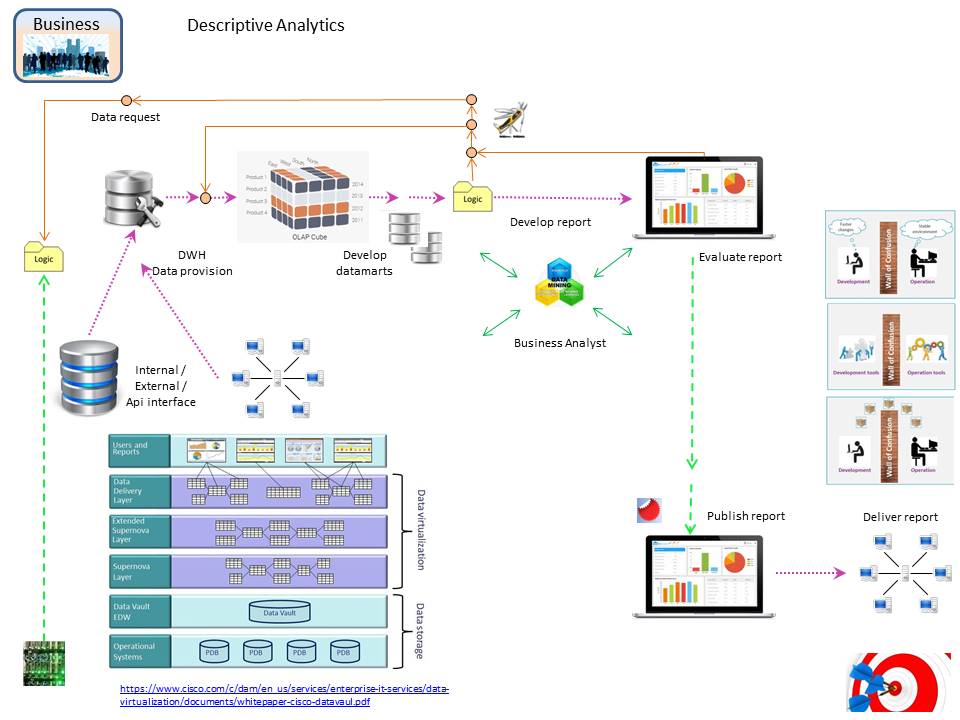
In this infographic flow:
- There is a need to build a DWH (DataWareHouse).
Being the only customer for a single purpose it is not a shared service.
No As A Service approach (DWH-AAS).
- The delivery is a dashboard (type of report) informing the customer that is responsible for continuity and / or change.
- There are many intermediate steps in extracting to an partial area of the information (datamarts), using possible many tools to achieve the presentations.
Those many intermediate steps easily causing delay in execution - delivery moment in time.
- Results are not delivered back electronical to operational systems.
The dashboards/reports serve as arguments to change the operations by decision makers.
- The dashboard/report only validated by manually review, segregation in duties.
There is no versioning release management with a DTAP.
- The data modelling, dedicated for each, is rather strict being as least in 3nf.
Not allowing for incomplete inconsistent data.
- Time / dates is the standard horizontal axis when plotting them in defined fixed time periods.
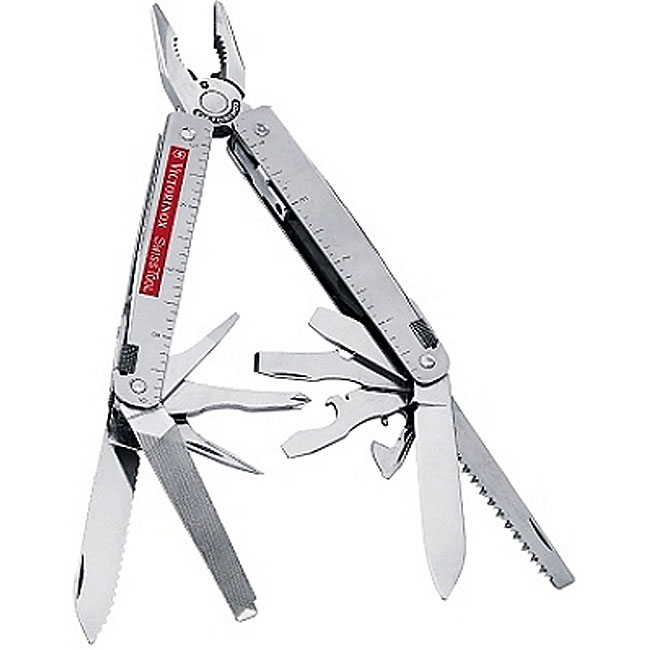
Using Bi-tools
💣 The tools originally reserved for BI only use have become far more generic.
With the type of BI&A usage there is already a list of four different type of users a "datawarehouse" - "data lake" should able to provide.

Analytical Proces
Automatization of decisions within predefined settings and predefined limits of variation.
Any automated decision has to be explainable and able to possible be correct by human intervention. (profiling GDPR)
ALC model3 BI&A.
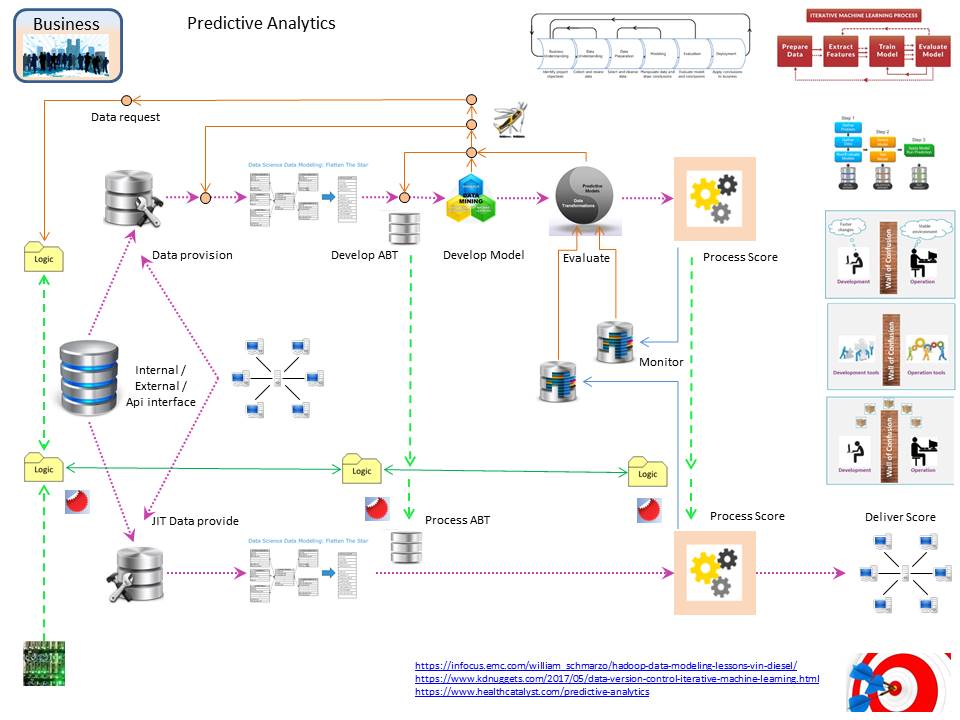
In this infographic flow:
- There is a need to collect a central datastore, DataLake.
The datamart of a DWH could be used but:
- That one is too late with data delivery, availablity
- Having modified data where sparse pecualiar information can be the one that is searched for
- The delivery can be
- a dashboard (type of report) informing the customer that is responsible voor continuity and / or change. He can make the decisions on that.
- an automated proces of profiling - scoring giving a list of observations being expected the best candidates (ML).
- The automated logic generation is asociated with numbers like lift accuracy expected profit. Those are the number and figures helping the responsible person in decisions on what to do.
- There are four lines (vertical green + external connection) for versioning and release management. The list:
- Preparing data that can be used by data scientists.
Having modified data containing sparse pecualiar information can be the one that is searched for
- Preparing data by datascientist in a way that they are suited for the statistical processing.
- The resulting generated code on the transformed data by the datscientist.
- Delivery of the scoringresults associated to subjects.

- Scoringresults with the input are new important information to be archived along wiht the used version of the model.
- Make this proces reliable controllable several checkpoints monitoring the scoring proces are required.
- The data model looks to be a star-schema in 3nf. It is an ER relationship allowing missing cardanalities and invalid data.

Inventing changing Operations.
💣 Analysing data is requiring real operational production data. Building decisons on faked information would generate very wrong results.
Whether it is basic analytics doing reporting or automatized ML it is =level 3= (orange).
EMC - Big Data infographic (2013)
A nice review on this, "The big data journey rivisited" Bill Schmarzo 2016.
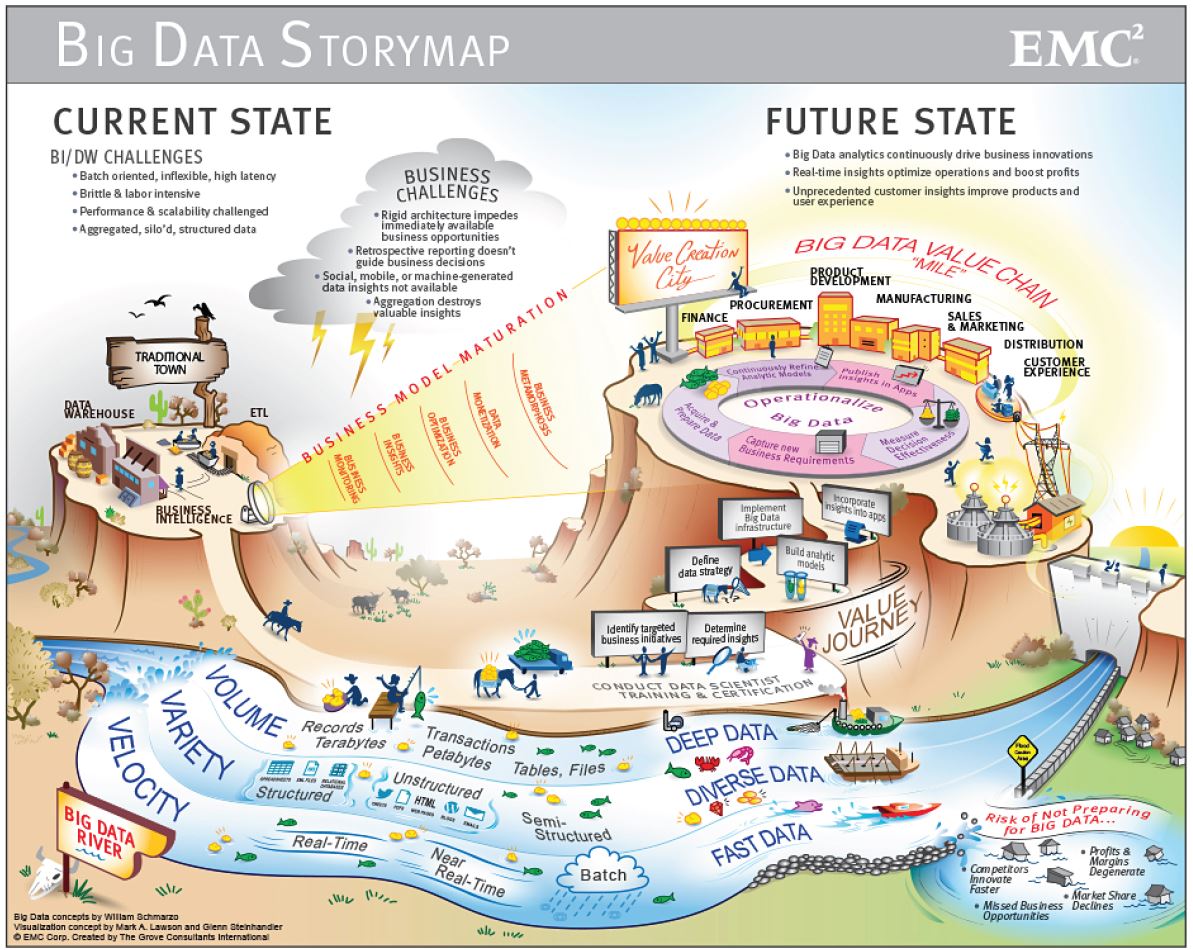
Combined pages as single topic.

👓 info types different types of information
👓 Value Stream of the inforamtion product
👓 transform information Working cell
✅ bi tech Business Intelligence, Analytics
🕶 data silo - BI analytics, reporting
🔰 Most logical
back reference.
AH-2 Details systems ZARF internals 6x6 reference framework
AL-2.1
. . . . . . . . . . . . . . . . . . . . . . . . . . . . . . . . . . . . . . . . . . . . . . . . . . . . . . . . . . . . . . . . . . . . . . . . . . . . . . . . . .
⟲ AL-2.2.1 Info
butics
AL-2.2
. . . . . . . . . . . . . . . . . . . . . . . . . . . . . . . . . . . . . . . . . . . . . . . . . . . . . . . . . . . . . . . . . . . . . . . . . . . . . . . . . .
⟲ AL-2.3.1 Info
Formulating the challenge of the good regulator implementation by humans
A typology of system agents like inventors and diplomats. System 2 – Diplomats stabilize relationships, optimize communication between subsystems (e.g., departments, nations, stakeholders).
They maintain systemic cohesion in real time.
- Conductor Orchestrates timing and synchronization across units
Runs cross-unit rhythm sessions to align calendars, SLAs
- Translator Ensures common language and semantics
Maintains a shared glossary; resolves terminology gaps
- Buffer Manager Regulates safety stocks, capacity and slack
Monitors real-time work-in-progress and adjusts buffers
- Gatekeeper Controls flows at critical interfaces
Screens, routes, and protocols incoming/outgoing requests
- Harmonizer Minimizes friction and conflict in handoffs
Facilitates joint process-tuning workshops
- Steward Allocates resources and enforces accountability
Rebalances budgets, personnel, assets among operational units
- Risk Officer Anticipates systemic risks and designs mitigations
Runs stress tests, maintains a living risk-heat map
- Portfolio Manager Curates and governs the internal project/service portfolio
Reviews, prioritizes and green-lights unit proposals
- Integrator
Performance Analyst Synthesizes operational reports for executive oversight Tracks KPIs, trends and system health
Crafts System 3* review briefs and recommends synergies
Publishes weekly dashboards and triggers corrective interventions
- Auditor Verifies compliance, quality and procedure adherence
Conducts rotational audits and publishes deviation reports
How They Interrelate
- Conductor ↔ Steward The Conductor surfaces schedule clashes; the Steward reallocates resources to resolve them.
- Translator ↔ Portfolio Manager Shared terminology ensures project proposals are clearly understood and evaluated.
- Buffer Manager ↔ Risk Officer Real-time buffer metrics feed into risk forecasts and early-warning signals.
- Gatekeeper ↔ Integrator Interface controls guarantee only validated data reaches executive summaries.
- Harmonizer ↔ Auditor Insights from process workshops inform the Auditor’s compliance checks.
The end of the hierarchical organisation in the scope of decision making
Jabes documentation a rich structure that supports this edge empowerment:
- CES-Jabes aligns enterprise processes with maturity and mission—echoing Agile’s focus on value delivery.
CES (Control Enterprise Systems) ➡ Business processes
Strategic → Vision, leadership, long-term planning
- CPI-Jabes emphasizes controlled innovation and change—mirroring Agile’s iterative cycles.
CPI (Control Process Innovation) ➡ Change & innovation
Tactical → Coordination, alignment, mid-term planning
- CTO-Jabes focuses on build/run/devops across strategic, tactical, and operational layers.
CTO (Control Technology Operations) ➡ DevOps & IT delivery
Operational → Execution, delivery, short-term responsiveness
This forms a 3×3 matrix—a perfect scaffold for a DevOps maturity model.
The Jabes model doesn’t just support DevOps—it extends it by embedding it in a broader organizational philosophy of sense-making, stewardship, and systemic alignment.
his shift faces resistance. Why?
- Legacy systems reward control, not collaboration.
- Middle management often fears loss of relevance.
- Cultural inertia slows transformation.
But DevOps and Agile offer a pathway to maturity—not just technical, but organizational and human. Your Jabes framework provides the scaffolding to guide that journey.
AL-2.3
. . . . . . . . . . . . . . . . . . . . . . . . . . . . . . . . . . . . . . . . . . . . . . . . . . . . . . . . . . . . . . . . . . . . . . . . . . . . . . . . . .
⟲ AL-2.3.1 Info
butics
Consolidating are's in the 6*6 reference frame
By embedding these consolidation patterns the framework gains a powerful mechanism for managing complexity—allowing teams to zoom in when needed and zoom out when appropriate, all while preserving the integrity of transformation logic.
Use Case: When two interrogatives intersect with two abstraction layers to form a tightly coupled operational domain.
Example: “How–Technology” and “What–Technology” paired with “How–Component” and “What–Component” Consolidated into a domain like “Functional Implementation”
Implication: Enables focused optimization of delivery pipelines or engineering subsystems. Ideal for agile teams working on bounded feature sets or modules.
2×2 Consolidation:
Tactical Domain Bundling | What | How |
| Engineering | Technology choice | Platform usage |
| Technician | Components in technology | Processing by the platform |
Use Case: When three interrogatives span three abstraction layers to form a strategic capability cluster.
Example: “Who–Context”, “When–Context” and “Which–Context” paired with “Who–Concept”, “When–Concept” and “Which–Concept” to “Who–Logic”, “When–Logic” and “Which–Logic” Consolidated into a domain like “Governance & Planning”.
Implication: Supports executive decision-making, scenario modeling, and long-range planning. Useful for aligning missions, visions, and stakeholder roles “Governance & Planning”.
3×3 Consolidation:
Strategic Domain Mapping | Who | When | Which |
| Context scope | Chief Executive | Set moments for decisions | Options in decisison |
| Concepts Business | Chief Product | Impact of decisions by time | Scenarios by change options |
| Logic System | Architect | System expectations by time | System change options |
The uniqueness of the Jabes proposal
(I think this is all content for a SmartSystem.)
Consolidation of systems thinking into Jabes
LLM question: Is there something like Jabes already existing? (sept 2025)
Asking a LLM (Large language Model) whether this already is existing, results in a list of building blocks to create that yourself.
- FIBO (Financial Industry Business Ontology) for instruments, processes, roles
- ISO 20022 message definitions for payment flows
- XBRL taxonomies for regulatory filings
- PROV-O + P-PLAN for design & validation provenance
- disicpline ontologie: W#C DPV for privacy, FIBO for finance, IFCowl for construction, plus P-PLAN for tests.
- RDF triple store hosting ifcOWL + PROV-O + P-PLAN
- ISO 15926 for process-industry asset life cycles
- DokuWiki or MediaWiki - Confluence (Atlassian) - Obsidian or Notion - TagSpaces - Neo4j with a Zachman Ontology - Stardog or Ontotext GraphDB
While Jabes as described in your page is a unique concept, there are several existing tools that echo parts of its vision.
Jabes aims to unify knowledge management, advisory logic, and communication support into a single, adaptive system.
That’s ambitious, and most current tools only cover slices of that functionality.
While no tool fully embodies Jabes’ vision of embedded SIAR logic, fractal reference frames, real-time Gemba feedback, compliance metadata, and ambient governance, several enterprise solutions come closer than basic wikis or KBs—and even layer on AI-driven advisory. Below is a comparison of the front-runners:
| Tool Platform | What It Does Well Jabes-Like Features |
| Guru | Real-time knowledge network; AI suggestions; Slack/MS Teams integration; card-based context pop-ups Pushes contextual advisory “cards” into workflows; tracks accountability and confidence scores |
| Notion | All-in-one workspace for docs, databases, wikis Flexible structure, collaborative editing |
| ONES Wiki | Enterprise-grade knowledge base Structured advisory content, versioning |
| Document360 | Technical documentation & knowledge base Role-based access, analytics, feedback loops |
| Tettra | Lightweight internal wiki with Slack/MS Teams Advisory prompts, team Q&A integration |
| Bloomfire | AI-powered content recommendations; semantic search; dynamic Q&A; analytics on content usage Injects advisory logic by surface “next best answers” and usage insights for continuous improvement |
| Stonly | Interactive decision-tree guides; embedded tutorials; role-based branching; feedback loops Guides users step-by-step through SIAR-style decision flows and captures outcome metrics |
| ONES Wiki | Enterprise wiki + Copilot-like AI; template-based SIAR playbooks; analytics dashboards Supports structured SIAR cycles via customizable templates; measures “Situation→Result” outcomes |
| Slite | Block-based collaborative docs; automated table of contents; smart notifications; Slack integration Provides deep customization of fractal reference frames; nudges teams when content stales |
| Atlassian Confluence | Marketplace apps for decision trees, analytics, governance; advanced permission schemes With add-ons, can embed guided decision flows, audit trails, and policy-inheritance rules |
| | |
Gaps & Next-Gen Extensions
Even these advanced platforms fall short of Jabes’ full remit. To push further, one could:
- Fractal Cell Mapping: Integrate a ZARF-style 6×6 mesh so knowledge artifacts auto-land in unique cells, preserving boundaries.
- Real-Time Gemba Feeds: Extend IoT or sensor streams directly into the advisory engine—so metric shifts trigger fresh SIAR prompts.
- Agentic Orchestration: Layer in an event-driven agent framework that choreographs multi-cell transformations and handles rollback via compensation paths (ZARF_EXC_01).
- Ambient Ethics Engine: Bake policy rules into the advisory layer so every recommendation inherently respects compliance constraints (ZARF_GOV_01).
What Jabes Adds That’s Missing
Most tools above focus on documentation or collaboration, but Jabes proposes:
- Integrated Lean + SIAR logic: Not just storing knowledge, but guiding decisions through structured cycles (Situation → Ideas → Analysis → Result)
- Closed-loop feedback: Real-time metrics from Gemba or cyber processes feeding back into advisory logic
- Compliance & accountability metadata: Tracking who is responsible, informed, or accountable per decision
- Fractal reference frames: Mapping knowledge into structured cells (like ZARF or 6×6) for clarity and traceability
- Ambient governance: Not post-hoc control, but embedded ethics and decision boundaries
If Jabes were to be prototyped today, it might look like:
- A Notion/Guru hybrid with embedded SIAR templates
- A BI dashboard that links metrics directly to advisory prompts
- A compliance-aware wiki that logs decisions, roles, and outcomes
- A chat interface that guides users through recursive “Which” questions per ZARF cell
AL-2.4.1
. . . . . . . . . . . . . . . . . . . . . . . . . . . . . . . . . . . . . . . . . . . . . . . . . . . . . . . . . . . . . . . . . . . . . . . . . . . . . . . . . .
⟲ AL-2.4.1 Info
butics
Platform Engineering 6*6 Matrix: Semantic Mapping
The discipline of Platform Engineering in the Information Technology context, is primarily situated in the Technology domain, but it interacts deeply with People (stakeholders, users, operators) and Processes (budgeting, lifecycle, compliance).
Questions that help structure stakeholder understanding across context layers & abstraction layers.
❶ Alignment by What en How:
| What (define) | How (Categorize) |
Platform
Component | What are the components (e.g., CI/CD, observability, identity)? | How is it grouped (infra, app, data, security)? |
Decision
Node | What is the decision (e.g., upgrade, deprecate, patch)? | How is it structured (manual, automated, policy-driven)? |
Stakeholder
Role | What is the role (e.g., platform engineer, SRE, architect)? | How is it categorized (builder, operator, enabler)? |
| Resource | What is the resource (e.g., compute, storage, licenses)? | How is it classified (shared, dedicated, ephemeral)? |
Feedback
Loop | What feedback is generated (metrics, logs, alerts)? | How is it structured (push/pull, closed/open)? |
Governance
Rule | What policy applies (e.g., access, compliance)? | How is it enforced (RBAC, audit, automation)? |
❷ Alignment by Where en Who:
| Where (Classify) | Who (Name) |
Platform
Component | Where is it deployed (cloud, edge, hybrid)? | Who owns or maintains it? |
Decision
Node | Where does it apply (domain, environment)? | Who decides or approves? |
Stakeholder
Role | Where does it act (infra, app, governance)? | Who embodies the role (persona, team)? |
| Resource | Where is it allocated (cluster, tenant)? | Who consumes or provisions it? |
Feedback
Loop | Where is it routed (dashboard, alerting system)? | Who receives or acts on it? |
Governance
Rule | Where is it scoped (global, local, tenant)? | Who governs or escalates? |
❸ Alignment by When en Which:
| When (Time) | Which (Distinguish) |
Platform
Component | When is it provisioned, scaled, retired? | Which components are critical, optional, redundant? |
Decision
Node | When is it triggered (event, schedule)? | Which options are viable, risky, deferred? |
Stakeholder
Role | When is the role active (lifecycle stage)? | Which roles overlap or conflict? |
| Resource | When is it needed or constrained? | Which resources are bottlenecks or elastic? |
Feedback
Loop | When is it reviewed or escalated? | Which feedback loops are convergent or noisy? |
Governance
Rule | When is it evaluated or refreshed? | Which rules are flexible, strict, obsolete? |
Fractals for details getting to work instructions in Platform engineering
🚧 ZARF Integration:
- Anatomy Axis: Use vertical layers (Context → Instance) to show how platform components evolve from abstract capability to concrete deployment.
- Physiology Axis: Use horizontal flows (Engineering, Administration, Delivery, Supply) to show how platform decisions propagate across domains.
- Time Slices: Apply Now / Near Future / Far Future overlays to model lifecycle, roadmap, and transformation logic.
- Recursive “Which”: Drill into trade-offs, prioritization, and scenario modeling for platform evolution.
⌛ ⏳What is next, Visual Implications.
(LLM:)
Resulting Artifacts:
- A Platform Engineering Compass for decision modeling
- A Role-Task Matrix for stakeholder alignment
- A Feedback-Governance Overlay for closed-loop control
- A Resource Allocation Map for bottleneck detection
- A Scenario Planner for roadmap and budget alignment
Would you like to co-design one of these artifacts—say, the Platform Engineering Compass or the Role-Task Matrix—using your ZARF overlays and AK-1.4 feedback logic?
Formulating the challenge of the good regulator implementation by humans
| Sytems Role | Boundary Crossing | Boundary setting | Knowledge |
| preserving | Validator Analytical, quality-focused, coherence enforcer
Preserves systemic boundaries and semantic integrity | Healer Empathic, harmonizing, relational
Restores trust and cultural alignment | Constructor Reliable, structured, intentional builder
Builds intentional systems and semantic scaffolds |
| describing prescribing | Cartographer Analytical, structured, reference-based
(or System Framer): Frames and prescribes boundary logic | Diplomat Mediates interests and prescribes alignment | Philosopher Deep thinker, conceptual innovator
Prescribes conceptual clarity and epistemic integrity |
| transforming | Trickster Challenges norms, provokes action
Disrupts and transforms boundaries to reveal hidden tensions | Prophet Visionary, networked, future-oriented
Provokes future-oriented coherence and cultural foresight | Inventor Creative, idea generator
Transforms knowledge through creative synthesis |
Traits of Meta-Agents are fluidly traverse systems, often creating friction or synthesis between domains.
System 4 – Inventors scan the environment, introduce new patterns, imagine futures. They anticipate discontinuities and trigger adaptive learning or redesign.
Thea Sends probes into the future, introducing new potential
Meta-Agents System 4:
| Role | Why They Belong Here |
| Explorer (Horizon-Scanner) | Systematically surveys technological, market, cultural and ecological landscapes for weak signals. | Conducting trend analyses and scanning adjacent domains. |
| Boundary Spanner | Translates across disciplinary, organizational or cultural divides. | Facilitating cross-domain workshops and residencies. |
| Pattern Reader (Complexity Theorist) | Detects recurrent motifs—bifurcations, cascades, emergent orders—within evolving systems. | Applying network analysis, agent-based modeling, pattern language. |
| Cartographer (Mapmaker) | Visualizes dynamic system architectures, flows, and feedback loops to make complexity legible. | Designing interactive system-maps or causal loop diagrams. |
| -- Futurist (Prophet) -- | Articulates compelling visions that emotionally mobilize stakeholders toward new horizons. | Publishing manifestos, keynote provocations, thought pieces. |
| Ethnographer | Observes emerging practices, rituals, and user behaviors to ground System 4 insights in lived reality. | Field immersions, contextual interviews, and diaries. |
| Opportunity Curator (Portfolio Manager) | Curates a balanced set of prototypes, pilot projects, and investments to hedge bets. | Allocating resources across incremental, adjacent and radical bets. |
| Network Weaver | Builds coalitions and innovation ecosystems—linking startups, labs, universities, and communities. | Orchestrating hackathons, consortiums, living labs. |
| Scenario Planner | Crafts multiple “what‐if” futures to stress-test current strategies and surface inflection points. | Building detailed narrative maps of plausible futures. |
| Role | Why They Belong Here |
| Explorer & Scenario Planner | Combine real-world scouting with imaginative forecasting to ensure visions are both grounded and expansive. |
| Boundary Spanner & Network Weaver | Translate insights into collaborations, ensuring that breakthroughs don’t remain siloed. |
| Pattern Reader & Opportunity Curator | Identify systemic leverage points and allocate experimentation resources where returns (or learnings) will be maximized. |
| Ethnographer & Cartographer | Anchor speculative futures in rich, qualitative data and make them visible through maps and models. |
A viable system needs tension between System 3 and System 4:
Too much diplomacy (System 3) = stagnation, over-regulation.
Too much invention (System 4) = chaos, detachment from operational reality.
This dance creates dynamic viability.
The inventor projects horizons, the diplomat grounds transformation within the system’s coherence.
One seeds novelty; the other ensures it doesn’t burn the house down.
System 5 (Meta-Agent) – Harmonizes values between past, present, and future. Ensures transformations serve the system’s deeper identity.
They Harmonizes values between past, present, and future. Ensures transformations serve the system’s deeper identity.
Meta-Agents System 5:
| Role | Why They Belong Here |
| () Philosopher | Questions the system’s premises, ethics, and direction. Defines the “why” behind the what. |
| Visionary Leader | Channels invention into coherent narratives. Keeps the soul of the system intact amid change. |
| Meta-Strategist | Reconciles the logic of diplomacy and invention—preserves values while evolving systems. |
| Cultural Architect | Encodes meaning in rituals, symbols, language—making change feel like continuity. |
AL-2.5.1
. . . . . . . . . . . . . . . . . . . . . . . . . . . . . . . . . . . . . . . . . . . . . . . . . . . . . . . . . . . . . . . . . . . . . . . . . . . . . . . . . .
⟲ AL-2.5.1 Info
butics
Thinking references - quadrant (2*2), 9-plane (3*3) or 6*6 matrix models
Ordening categorizing the thinking mindset is putting them is some framework. The most used one is a quadrant. The advantage is usage for the most simple questions for what to choose.
For example:
- Which are the ones that are applicable for a situation
- What are the global relationships in this limited setting.
The disadvantage is is that is very limited by that limited options. For example the shown quadrant for systems thinking:
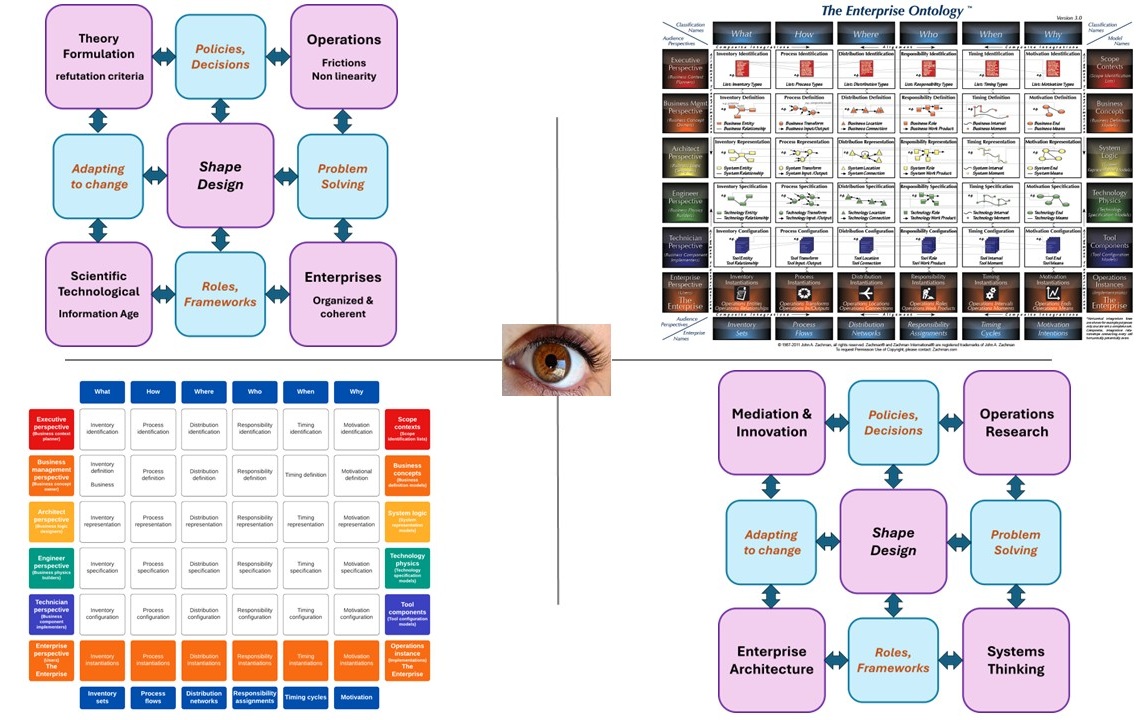
The question of what complexity is hidden too much, is avoiding oversimplification.
- A quadrant is a simplification of a 6*6 plane by reduction a consolidation of cells.
- A 9-plane is a simplification of a 6*6 plane by reduction a consolidation of cells.
In the 6*6 matrix model there is some agreement but still a lot of confusion. The accepted understanding for the vertical axis is that it is an ordered abstraction. These are:
- Context, eg EA: Executive perspective
- Concept, eg EA: Business management perspective
- System logic, eg EA: Architect perspective business logic
- System Technology, eg EA: Engineer perspective for the Physics
- Components, eg EA: Technician perspective
- Operational instances. eg EA: Enterprise perspective of the internal involved persons.
The confusion immediate starts in wanting to see this ordered vertical axis as a linear flow but the intention is about interactions and transformations in both directions by the neighbours of the cells.
The horizontal axis never got an agreement although a proposed ordering did start.
That ordering is set by an engineering context, a technological perspective, there is also a trade perspective.
The context for the understanding, knowledge resources and skills that are needed are slightly different.
- The perspective of being a service by a system in an environment.
- The perspective of operating an engineering a service within a system
The trade perspective offering a product/service needing resources:
- External: Where do we get the necessary external resources (broadly speaking)
- Internal: How do we deploy the internally available resources (operations)
- Internal: What will be delivered (operational planning)
- Internal: What options exist for improvements and different deliveries (tactical vision)
- Internal: When are improvement and change are possible (tactical vision)
- External: To whom can what be delivered (the market) sim
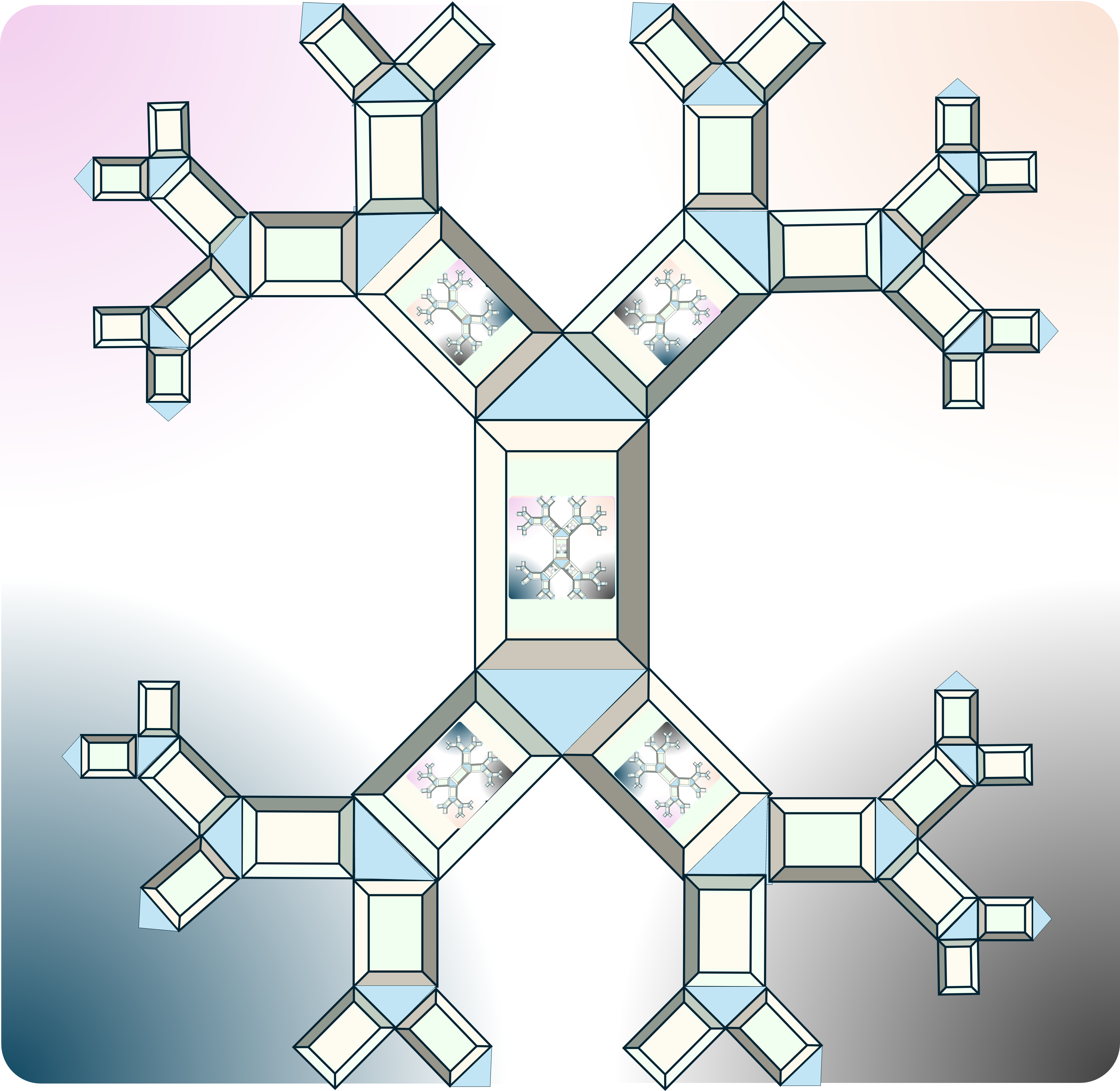
The engineering perspective from identification to instantiation:
- External: What external resources are needed, inventory
- Internal: How do process materials & resources
- Internal: Where will the components in processes get executed
- Internal: Who has the responsibility for the involved activities
- Internal: When will it get processed, the timing
- External: To whom will te results get delivered, the motivation of activities
In this way also the horizontal axis is ordered. the same challenge in confusion by wanting to see this as a linear flow but the intention is about interactions and transformations in both directions.
By this we have a geographical map for activities with only horizontale and vertical interactions.
There is however a third dimension of time, for every cell the own history is also interacting from the past in the now to the future.
Although the simple usual presentations are 2D there are really projections of at least three dimensions (3D)!
- Uncertain Future: Supporting, enabling changes that could become operational
- Estimated Future: Preparing changes that could become operational
- The now: Executing the operational activities
- The now: Supporting, enabling the operational activities
- Paste Known: "what has always been done that way" with known underpinned reasons
- Paste Unknown: "what has always been done that way" but the knowledge why has lost
There are more dimensions than these three, these are:
- values of any kind, not only financials
- the way and options for adaptions, innovation to any kind of changes
- Knowledge reference frames to use for content in build maintain and share
The usual oversimplification by models is hiding too much of all these dimensions.
Fractals creating Jabes Zarf wheel 6*6 patterns
Connecting all those rules and using the "Communities of practice success wheel" as useful example.
there are 8 important topics extending to 16
- Ideate - Drive - Objectives: Defined Vision - Extracted missions
- Plan - Steer - Sponsorship: Control - good practices
- Enable - Steer - Leadership: Servant / facilitating - enablement
- Demand - Build - Boundary Spanning: Supply in knowns - at unknowns
- Backend - Build - Risk free acting: Nurture group actors - over groups
- Frontend - Manage - Working force: encourage good habits, qualltiy cultivation
- Deliver - Manage - Tools & experiences: avoid confusion, customer centric
- Asses - Drive - Quality measurement alignment
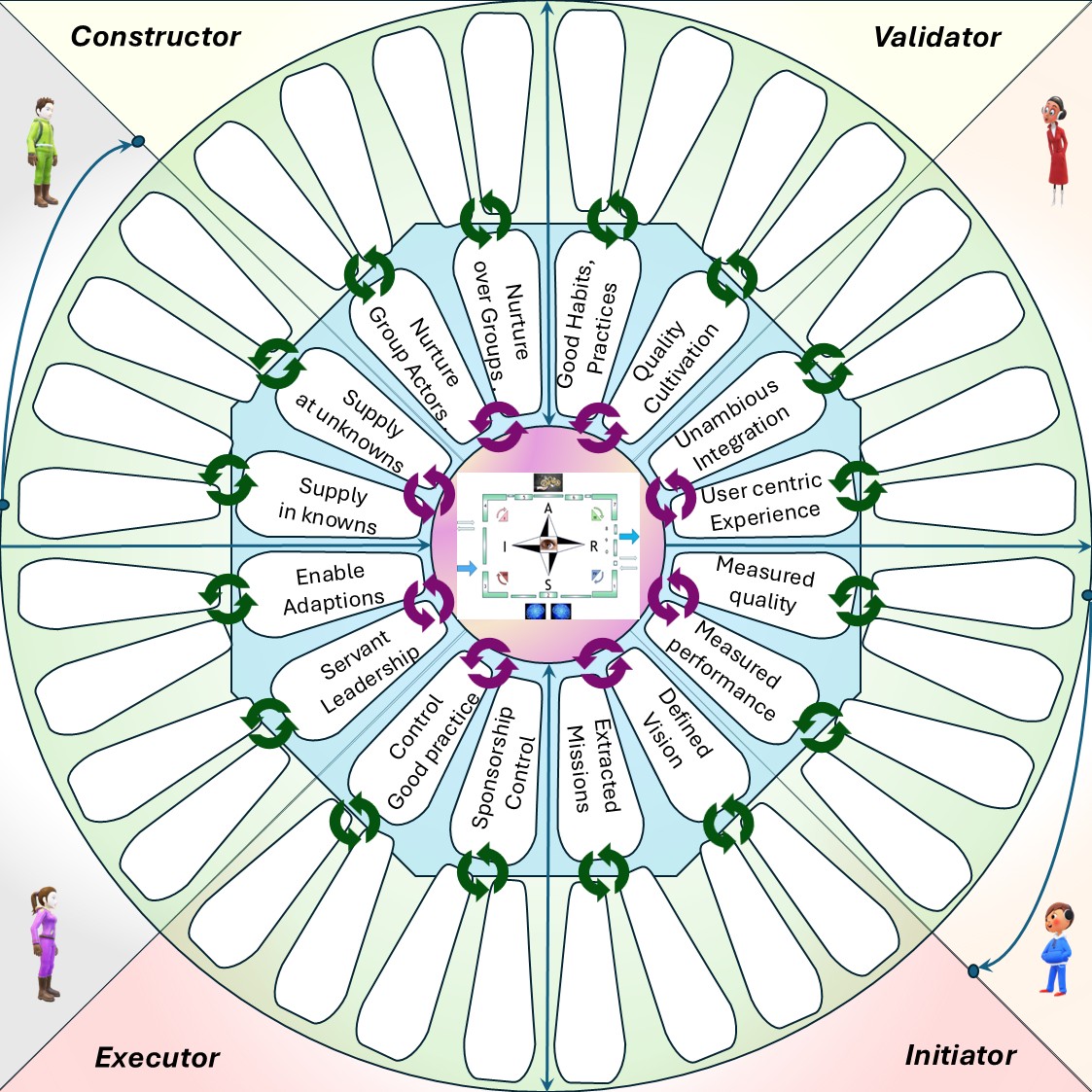
In a figure:
See right side.
In the centre the SIAR model defining 2* directions but also starts with a 9-plane that is a consolidations of 2*2 - 6*6 reference frames.
A blue area that is set by 8 area's when connected details for those 2*2 - 6*6 reference frames.
A green area for 4*4 - 6*6 reference frames, growing tensions into disconnections.
AL-2.6.1
. . . . . . . . . . . . . . . . . . . . . . . . . . . . . . . . . . . . . . . . . . . . . . . . . . . . . . . . . . . . . . . . . . . . . . . . . . . . . . . . . .
⟲ AL-2.6.1 Info
butics
AH-3 Details systems ZARF externals 6x6 reference framework
AL-3.1
. . . . . . . . . . . . . . . . . . . . . . . . . . . . . . . . . . . . . . . . . . . . . . . . . . . . . . . . . . . . . . . . . . . . . . . . . . . . . . . . . .
⟲ AL-2.2.1 Info
Mapping of abstraction semantic for using BRules
ZARF in public trust, recovery across Layers & Time Slices
Crisis Scenario: Digital service outage during benefits time window.
Layer Interactions:
- STRC (Anatomy) maps the structural impact and time horizon of the failure.
- INTR (Physiology) governs how cells interact to contain and correct the issue.
- VIRU (Neurology) ensures governance, logs actions, and orchestrates recovery.
- XPOS (Sociology) manages the social narrative, cultural fit, and trust restoration.
Now (Immediate Response):
| Layer | stage | |
| ---- | What | An event to act for in a crisis response model |
| STRC | How | Identify affected cells: What Component, Who Instance, When Technology |
| INTR | Where | Trigger horizontal updates: Who Instance ↆWhen Component |
| ---- | Which | selected prepared crisis response model |
| VIRU | When | Activate exception path: rollback What Component, notify Who Instance |
| XPOS | Who | Reassert identity: "Citizen-first, transparent, accountable" |
Near Future (Stabilization):
| Layer | stage | |
| ---- | What | Root cause analysis |
| STRC | How | Redesign How Logic and Where Technology to prevent recurrence |
| INTR | Where | Consolidate 2*2: What Technology + How Technology - "Recovery Engine" |
| ---- | Which | Knowledge consolidation root cause(s) |
| VIRU | When | Orchestrate composite recovery via System-2 cell, log all actions |
| XPOS | Who | Adapt messaging and behaviour to cultural expectations, engage stakeholders |
Far Future (Resilience & Renewal):
| Layer | stage | |
| ---- | What | Concept adjustments in correcting root causes |
| STRC | How | Reframe Which Concept to include resilience as a design goal |
| INTR | Where | Consolidate 3*3: Which Concept, Who Concept, When Concept â†' "Trust Cluster" |
| ---- | Which | Specification adjustments covering the root cause corrections |
| VIRU | When | Embed feedback loops into How Logic and Which Context |
| XPOS | Who | Publish postmortem, launch listening sessions, reinforce legitimacy |
AL-3.2
. . . . . . . . . . . . . . . . . . . . . . . . . . . . . . . . . . . . . . . . . . . . . . . . . . . . . . . . . . . . . . . . . . . . . . . . . . . . . . . . . .
⟲ AL-2.3.1 Info
Roles, Tasks, Methodologies for a safe environment for the system as whole.
Safety in orderd external states axis
- Where 👁 Demarcation
- Define trust zones via network segmentation (VLANs, subnets, micro-segments) to isolate workloads and data.
- Map data classification (public, internal, sensitive, restricted) and enforce controls at each zone boundary.
- Gate all ingress/egress through identity-aware proxies or API gateways to make boundaries explicit.
- How 👁 Deny
- Apply principle of least privilege with RBAC/ABAC so entities see only what they absolutely need.
- Configure firewalls, network ACLs, and Zero-Trust Network Access (ZTNA) to block everything except whitelisted traffic.
- Use strong authentication (MFA, certificates, hardware tokens) before granting any access.
- What 👁 Delay
- Implement rate-limiting on login and sensitive APIs to thwart brute-force and automated scans.
- Plant canary tokens, dummy credentials, or hidden honey-files in critical systems; their use triggers alerts and stalls attackers.
- Design chokepoint proxies or jump-hosts that force lateral traffic through monitored sprint-break checkpoints.
- Which 👁 Deter
- Display legal banners, warning notices, and visible security posture cues (e.g., login quarantine pages, phishing-resistant UX).
- Run continuous security training and phishing drills to make every user a tripwire for social engineering.
- Publicize red-team findings, bug-bounty programs, or incident post-mortems to signal active defense.
- When 👁 Detect
- Centralize logs with a SIEM or XDR platform that correlates network, endpoint, and cloud telemetry in real time.
- Deploy EDR agents, network IDS/IPS, and anomaly-based monitoring to flag behaviour deviations.
- Use honeypots, deception networks, or attack-surface scanners to capture reconnaissance and lateral-movement attempts.
- Who 👁 Defend
- Maintain tested incident response plans, run tabletop exercises, and integrate IR into your CI/CD pipelines.
- Harden systems through patch management, secure configurations (benchmarks), and regular vulnerability assessments.
- Ensure immutable backups, disaster recovery rehearsals, and business-continuity workflows are always up to date.
Safety external goals in transfomations
transfromation reasoning
- Demarcation ➡ Deny By establishing clear boundaries, you know exactly where to enforce access controls and stop unauthorized connections.
- Deny ➡ Delay When a denial fails or is bypassed, slowing down an attacker gives your team more time to react and catch anomalies.
- Delay ➡ Deter As adversaries hit friction, overt deterrents reinforce that the environment is hostile and not worth their effort.
- Deter ➡ Detect Even when deterrence fails, an environment primed for visibility helps you spot intruders faster.
- Detect ➡ Defend With timely detection, your incident response playbooks can activate, containing threats before they escalate.
Safety negative results by assumptions
transfromation threats
Common Mistakes to Avoid in Transitions Between the Six D's
- Demarcation ➡ Deny Avoid assuming that simply drawing boundaries automatically enforces blocks.
Common errors include:
- Overlooking invisible data flows that bypass segmented networks
- Relying on perimeter firewalls alone without enforcing host-level access controls
- Failing to align demarcation zones with actual user and application trust boundaries
- Deny ➡ Delay Don't treat denial as the only barrier before introducing friction. Pitfalls often seen:
- Implementing blanket blocks without graduated throttling for borderline cases
- Neglecting to instrument rate-limits and canary tokens until after access controls are in place
- Forgetting to calibrate delays so they don't degrade legitimate user experience
- Delay ➡ Deter Resisting the urge to layer visible warnings once friction is in place can undermine deterrence. Watch out for:
- Skipping user-facing notices and legal banners after implementing slowing tactics
- Relying on hidden delays (e.g., silent throttling) without any overt signal to attackers
- Treating deterrence as a one-off rather than reinforcing it continuously through training and signage
- Deter ➡ Detect Failing to bake in detection after raising visible barriers leaves you blind to stealthy probes. Avoid:
- Assuming that warnings alone will halt reconnaissance or automated scans
- Overlooking monitoring of decoy assets (honeypots) once overt deterrents are visible
- Neglecting to correlate deterrence events (e.g., banner clicks) with log and alert streams
- Detect ➡ Defend Catching intruders without clear response steps turns alerts into noise. Common missteps include:
- Generating high-volume alerts without pre-defined playbooks for containment and recovery
- Not integrating detection tools into incident-response workflows and ticketing systems
- Delaying patching and hardening after an alert instead of triggering automated defense actions
By steering clear of these transition pitfalls, you ensure each flows smoothly into the next, building a coherent, layered cybersecurity posture that not only blocks threats but actively slows, warns, spots, and counters them.
AL-3.3
. . . . . . . . . . . . . . . . . . . . . . . . . . . . . . . . . . . . . . . . . . . . . . . . . . . . . . . . . . . . . . . . . . . . . . . . . . . . . . . . . .
⟲ AL-2.3.1 Info
States in the external purpose line
From a tool claiming to support "What are Frameworks?"
Application Portfolio Management
- Where 👁 Manage your Application Portfolio in one solution. Perform Lifecycle Assessment, T.I.M.E. Analysis, and improve your data quality on an ongoing basis.
- How 👁 Align your investment portfolio with capability maps to better connect strategic goals and critical functions.
- What 👁 With single source of truth, manage your master data to make business impact decisions, and ensure business continuity
- Which 👁 Map your Business Processes, gain holistic overview of which processes support which value streams and business capabilities.
- When 👁 With our Information Objects, you can track your master flows through various integrations, and ensure ongoing GDPR compliance.
- Who 👁 Track your ideas to form initiatives from creation until approved state as visualised on digital roadmaps.
Changing states with the States in the external purpose line
- Plan (How) 👁 A digital knowledgebase for managing architecture processes, storing metadata, and ensuring transparency.
It supports decision-making, connects silos in a digital ecosystem, and provides governance.
Enterprise Architects oversee it, managing terms and keeping knowledge assets clear and accessible.
- Do (what) 👁 Strategic Planning to empower Business Architects to set strategic goals by aligning current Capabilities with future objectives through gap analysis.
This approach supports transformation planning, driving informed decisions and goal-focused change by integrating Business Architecture.
- Check (Which) 👁 Applications and Technology optimisation Helps optimise Applications and Technology by working with architects to simplify and standardise Processes.
With a focus on stability, these efforts improve efficiency and support long-term growth and transformation. With strong support for APM and standard management.
- Act (when) 👁 Capabilities for Portfolio Planning, combining strategic, tactical, and operational initiatives.
Optimisable gate-process ensures value creation aligned with strategic goals, not just cost allocation.
Also allowing Solution Architects to share their designs with each initiative.
AL-3.4
. . . . . . . . . . . . . . . . . . . . . . . . . . . . . . . . . . . . . . . . . . . . . . . . . . . . . . . . . . . . . . . . . . . . . . . . . . . . . . . . . .
⟲ AL-2.4.1 Info
butics
Each is structured to align with ZARF rules in values.
| | | | | | | |
| Pattern | Safety | 👐 | Fame | Wealth | 👐 | Honour |
| Typical Flows | Engineering + Delivery | Administration + Supply |
| Tension / Drivers | Secure design | 👐 | visibility/innovation | Cost efficiency | 👐 | Ethical standards |
| Time Abstraction | Now stabilization | 👐 | Near pilot | Near budget cycle | 👐 | Far governance |
| cell neighbours | Orchestrate: What-Who | Orchestrate: How-Which |
| Convergence | Risk reduction | 👐 | stakeholder trust | Budget adherence | 👐 | compliance audit |
--- MTTR (mean time to repair) QA (quality assurance)
| | | | | |
| Pattern | Speed | 👐 | Reliability | Autonomy | 👐 | Regulation |
| Typical Flows | Engineering + Platform | Delivery + Administration |
| Tension / Drivers | Throughput | 👐 | QA | Local freedom | 👐 | systemic control |
| Time Abstraction | Now throughput | 👐 | Near QA | Near tactical | 👐 | Far strategic |
| cell neighbours | Decisions: Where-How | Decisions: Who-When |
| Convergence | MTTR | 👐 | defect rate | decision latency | 👐 | Governance legitimacy |
AL-3.5
. . . . . . . . . . . . . . . . . . . . . . . . . . . . . . . . . . . . . . . . . . . . . . . . . . . . . . . . . . . . . . . . . . . . . . . . . . . . . . . . . .
⟲ AL-2.5.1 Info
butics
AL-3.6
. . . . . . . . . . . . . . . . . . . . . . . . . . . . . . . . . . . . . . . . . . . . . . . . . . . . . . . . . . . . . . . . . . . . . . . . . . . . . . . . . .
⟲ AL-2.6.1 Info
butics
© 2012,2020,2024 J.A.Karman


 The world of BI and Analytics is challenging.
The world of BI and Analytics is challenging. 















